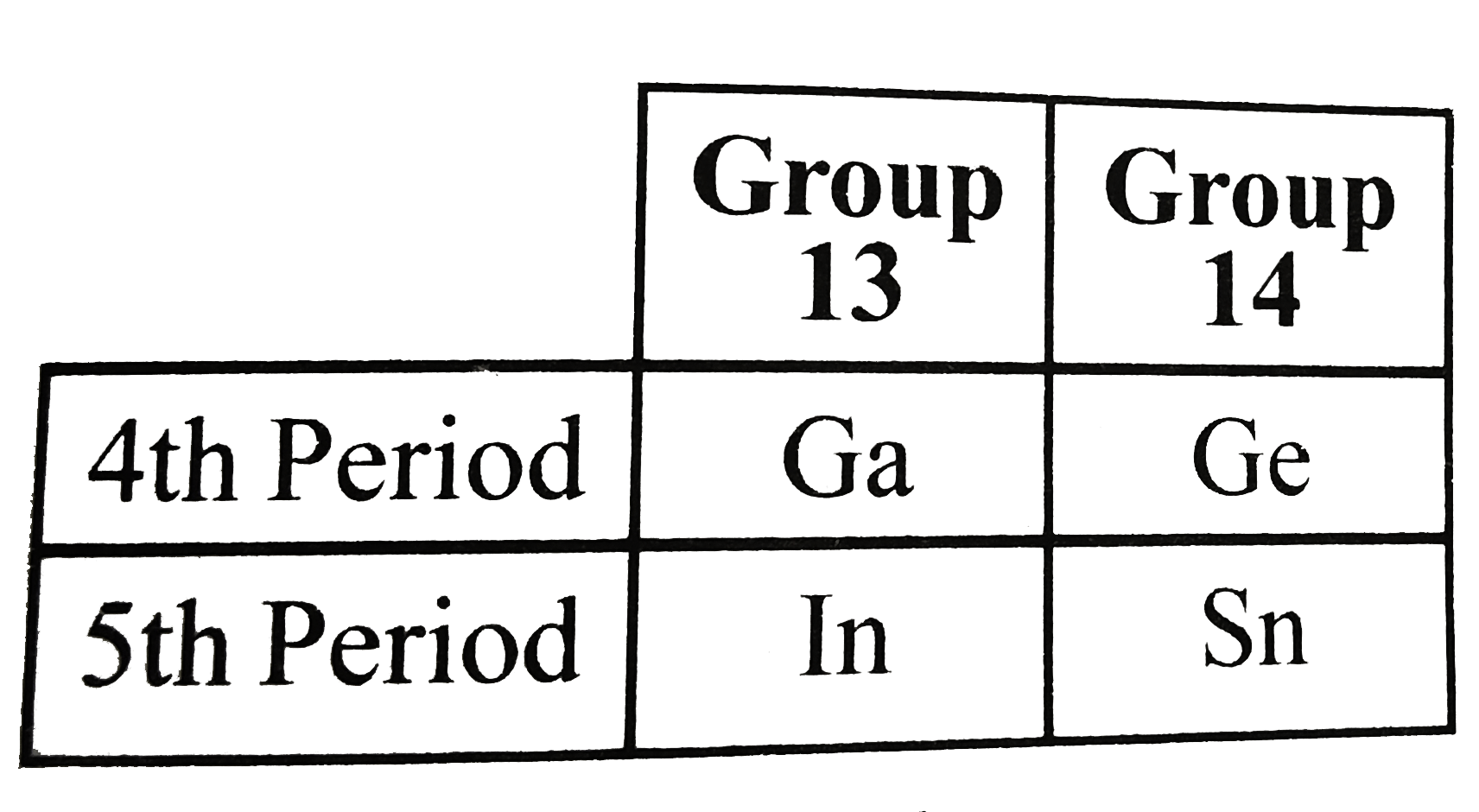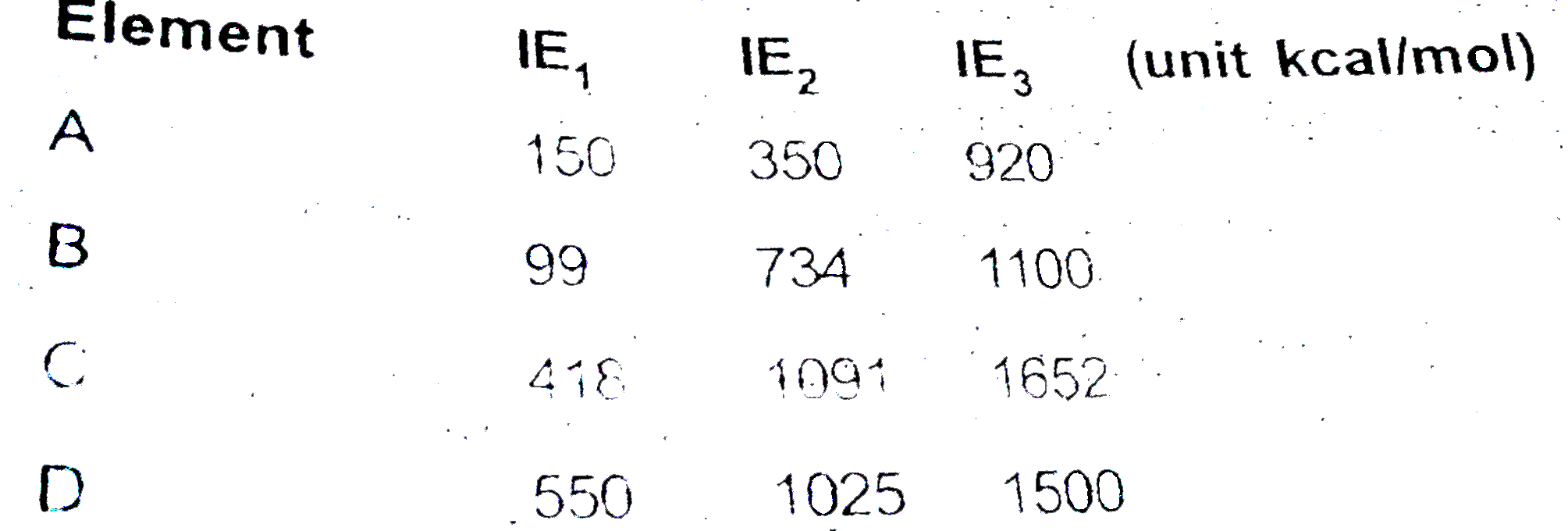The energy required to remove an electron from the outermost shell of an isolate gaseous atom is known as IE1 of that atom. Similarly, the enrgy required for the removal of the electron from the unipositive ion, diapositive ion and tripositive ion are known as IE2,IE3 and IE4 respectively, and are called successive ionisation energies. The magnitude of the charge depends on the size of the orbital of electron. Electrons in smaller orbitals are on average close with each other and have more repulsion. Thus for Be(2s2), the IE1 and IE2 are 9.3 and 18.2eVatom1, whereas for Ca(4s2), the values are 6.1 and 11.9eV.
Four elemensts have the following first ionization energies in KJmol−1:762,709,59 and 558. The elements are Ca,Ge. In and Sn (not in order). Which of these elements has the ionisation energy of 762KJmol−1?
In
Ga
Sn
Ge
The correct Answer is:D

So, Ge has the highest IE of 762kJmol−1.
Topper's Solved these Questions
- PERIODIC CLASSIFICATION OF ELEMENTS AND GENERAL INORGANIC CHEMISTRYBOOK - CENGAGE CHEMISTRYCHAPTER - PERIODIC CLASSIFICATION OF ELEMENTS AND GENERAL INORGANIC CHEMISTRYEXERCISE - Exercises (Multiple Correct) General Electronic Configuration And Periodicity
5 Videos
- PERIODIC CLASSIFICATION OF ELEMENTS AND GENERAL INORGANIC CHEMISTRYBOOK - CENGAGE CHEMISTRYCHAPTER - PERIODIC CLASSIFICATION OF ELEMENTS AND GENERAL INORGANIC CHEMISTRYEXERCISE - Exercises (Multiple Correct) Atomic And Ionic Radii
4 Videos
- PERIODIC CLASSIFICATION OF ELEMENTS AND GENERAL INORGANIC CHEMISTRYBOOK - CENGAGE CHEMISTRYCHAPTER - PERIODIC CLASSIFICATION OF ELEMENTS AND GENERAL INORGANIC CHEMISTRYEXERCISE - Ex 1.32 (Assertion-Reasoning)
2 Videos
- P-BLOCK GROUP 14 - CARBON FAMILYBOOK - CENGAGE CHEMISTRYCHAPTER - P-BLOCK GROUP 14 - CARBON FAMILYEXERCISE - Exercises Archives (Subjective)
9 Videos
- PURIFICATION OF ORGANIC COMPOUNDS AND QUALITATIVE AND QUANTITATIVE ANALYSISBOOK - CENGAGE CHEMISTRYCHAPTER - PURIFICATION OF ORGANIC COMPOUNDS AND QUALITATIVE AND QUANTITATIVE ANALYSISEXERCISE - Assertion Reasoning Type
5 Videos
Similar Questions
Which of the following statement (s) is/are correct ?
View SolutionWhich of the following is correct in order of increasing size ?
View SolutionAssertion (A) : IE1 of Mg is greater than that of Al.
Reason (R ) : It is easier to remove an electron fro 3s orbital than from 3p orbital.
View SolutionWrite the chemical equations involved in the extraction of lead from galena by self-reduction process.
View Solution(a). If both (A) and (R) are correct and (R) is the correct explanation for (A).
(b). If both (A) and (R) are correct and (R) is the correct explanation for (A).
(c). If (A) is correct and (R) is incorrect.
(d). If (A) is incorrect and (R) is correct. ltbr> (e). If both (A) and (R) are incorrect.
Q. Assertion (A): Essential oils are volatile and are isoluble in H2O
Reason (R): Essential oils are purified by steam ditillation.
View SolutionThe energy required to remove an electron from the outermost shell of an isolate gaseous atom is known as IE_(1) of that atom. Similarly, the enrgy required for the removal of the electron from the unipositive ion, diapositive ion and tripositive ion are known as IE_(2),IE_(3) and IE_(4) respectively, and are called successive ionisation energies. The magnitude of the charge depends on the size of the orbital of electron. Electrons in smaller orbitals are on average close with each other and have more repulsion. Thus for Be(2s^(2)) , the IE_(1) and IE_(2) are 9.3 and 18.2 eV "atom"^(1) , whereas for Ca(4s^(2)) , the values are 6.1 and 11.9 eV . The correct order of arrangement of the first ionisation energies of C, N,O and F ( in decreasing values) is
View SolutionThe energy required to remove an electron from the outermost shell of an isolate gaseous atom is known as IE_(1) of that atom. Similarly, the enrgy required for the removal of the electron from the unipositive ion, diapositive ion and tripositive ion are known as IE_(2),IE_(3) and IE_(4) respectively, and are called successive ionisation energies. The magnitude of the charge depends on the size of the orbital of electron. Electrons in smaller orbitals are on average close with each other and have more repulsion. Thus for Be(2s^(2)) , the IE_(1) and IE_(2) are 9.3 and 18.2 eV "atom"^(1) , whereas for Ca(4s^(2)) , the values are 6.1 and 11.9 eV . Which of the following are isoelectronic species? 1 rarrCH_(3)^(o+),IIrarrNH_(2)^(ɵ),IIIrarrNH_(4)^(o+),IVrarrNH_(3)
View SolutionThe energy required to remove an electron from the outermost shell of an isolate gaseous atom is known as IE1 of that atom. Similarly, the enrgy required for the removal of the electron from the unipositive ion, diapositive ion and tripositive ion are known as IE2,IE3 and IE4 respectively, and are called successive ionisation energies. The magnitude of the charge depends on the size of the orbital of electron. Electrons in smaller orbitals are on average close with each other and have more repulsion. Thus for Be(2s2), the IE1 and IE2 are 9.3 and 18.2eVatom1, whereas for Ca(4s2), the values are 6.1 and 11.9eV.
Among the following ionisation reactions, which one will have the maximum value of ionisation energy?
View SolutionThe energy required to remove an electron from the outermost shell of an isolate gaseous atom is known as IE_(1) of that atom. Similarly, the enrgy required for the removal of the electron from the unipositive ion, diapositive ion and tripositive ion are known as IE_(2),IE_(3) and IE_(4) respectively, and are called successive ionisation energies. The magnitude of the charge depends on the size of the orbital of electron. Electrons in smaller orbitals are on average close with each other and have more repulsion. Thus for Be(2s^(2)) , the IE_(1) and IE_(2) are 9.3 and 18.2 eV "atom"^(1) , whereas for Ca(4s^(2)) , the values are 6.1 and 11.9 eV . Consider the IE_(1) of the element whose electronic configuration correspond to the following:
View SolutionThe energy required to remove an electron from the outermost shell of an isolate gaseous atom is known as IE1 of that atom. Similarly, the enrgy required for the removal of the electron from the unipositive ion, diapositive ion and tripositive ion are known as IE2,IE3 and IE4 respectively, and are called successive ionisation energies. The magnitude of the charge depends on the size of the orbital of electron. Electrons in smaller orbitals are on average close with each other and have more repulsion. Thus for Be(2s2), the IE1 and IE2 are 9.3 and 18.2eVatom1, whereas for Ca(4s2), the values are 6.1 and 11.9eV.
The relationship between IE4 and IE2 of an element is
View SolutionThe second ionisation energies are higher than the first ionisation energies. This is mainly due to the fact that after the removal of the first electrons, the atom changes inot mono valent position ion. In the ion, the number of electrons decreases but the nuclear charge remains the same. As a result of this, the remaining electrons are held more tightly by the nucleus and it becomes difficult to remove the second electron . Therefore, the value of second ionisation energy . (IE_(2)) , is greater than that of the first ionisation energy (IE_(1)) . Similarly third ionisation energy (IE_(3)) is greater than that of second IE_(2) . Successive ionisation energy of an atom is greater than previous one, because
View SolutionIonisation energy is the amount of energy required to remove the outermost e− from a gaseous atom. It's unit is kJ/mole or kcal/mole.
Successive ionisation energy - It is the amount of energy required to remove electron successively from a gaseous ion. These are termed as IE2,IE3,IE4 etc. the difference in the values of IE1,IE2 and IE3 helps to determine electronic configuration of the element.

Which element forms stable unipositive ion ?
View SolutionIonisation energy is the amount of energy required to remove the outermost e^(-) from a gaseous atom. It's unit is kJ/mole or kcal/mole. Successive ionisation energy - It is the amount of energy required to remove electron successively from a gaseous ion. These are termed as IE_(2), IE_(3), IE_(4) etc. the difference in the values of IE_(1), IE_(2) " and " IE_(3) helps to determine electronic configuration of the element. Which of the following is a non-metal ?
View SolutionIonisation energy is the amount of energy required to remove the outermost e− from a gaseous atom. It's unit is kJ/mole or kcal/mole.
Successive ionisation energy - It is the amount of energy required to remove electron successively from a gaseous ion. These are termed as IE2,IE3,IE4 etc. the difference in the values of IE1,IE2 and IE3 helps to determine electronic configuration of the element.

Which element is a noble gas ?
View SolutionThe second ionisation energies are higher than the first ionisation energies. This is mainly due to the fact the after the removal of the first electron, the atom changes into monovalent positive ion. In the ion, the number of electrons decreases but the nuclear charge remains the same. as a result of this, the remaining electrons are held more tightly by the nucleus and it becomes difficult to remove the second electron. therefore, the value of second ionisation energy. (IE_(2)) , is greater than that of the first ionisatio energy (IE_(1)) . similarly third ionisation energy (IE_(3)) is greater than that of second IE_(2) . Q. Successive ionisation energy of an atom is greater than previous one, because:
View Solution
